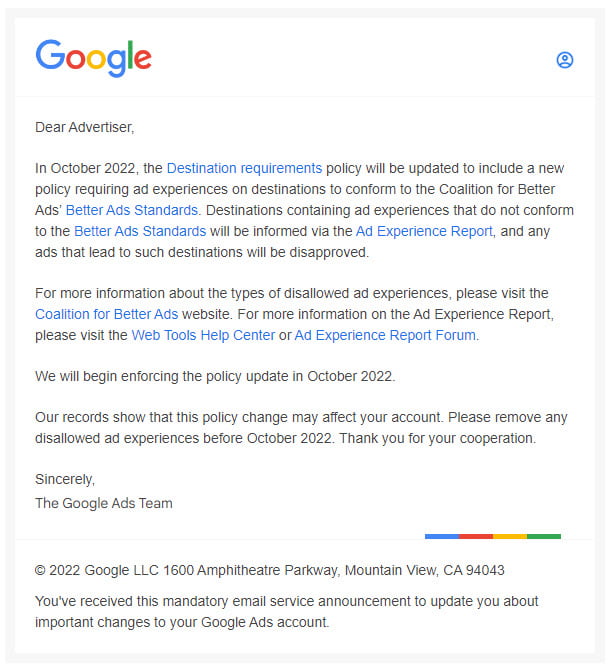There probably isn’t an internet user who hasn’t had a frustrating experience with online paid ads.
The major vendors who make their money on selling ad space online are aware of this and are trying to do something to improve it.
If you buy ad space for your business from Google, or Microsoft or Facebook then you need to be aware of some forthcoming changes.
The Better Ads Standards are a set of ad experience guidelines that were developed by the Coalition for Better Ads, an industry group that includes Google, Facebook, Microsoft, and many other companies.
The standards define what constitutes a “bad” ad experience, and Google has committed to ensuring that all ads on its platforms conform to these standards.

Google recently announced that the Destination requirements policy will be updated in October 2022 to require that all ad destinations comply with the Coalition for Better Ads’ Better Ads Standards.
This is a big change for Google and will impact all advertisers who are running ads on Google’s platforms.
The update to the Destination requirements policy is just one way that Google is working to improve the overall quality of ads on its platforms.
To make sure that websites follow the Better Ads Standards, Google runs a scan called the Ad Experience Report.
If any ads lead to destinations with ad experiences that do not meet the new standards, those ads will be disapproved.
While there are many nuanced and fairly technical reasons that an ad may not be compliant with the Better Ads Standards and thus be refused or blocked, some of the more common ones are as follows.
For a more complete list with specific examples please check out Googles Destination Requirements
For example: websites that have pop-ups or interstitials that block the user’s view of the content requested; sites that disable or interfere with the browser’s back button; websites that take a long time to load on most popular browsers and devices, or require downloading an additional application to view the landing page (aside from common browser plug-ins).
Images, video, sound, and documents are just a few examples. Please note that pharmaceutical advertisers are allowed to use PDF landing pages, as long as they meet the certified requirements.
Websites that redirect the page automatically without user action; websites that display ads that look like system or site warnings or error messages.
Google will begin disapproving ads that lead to destinations with these experiences starting October 2022. So if you have any ads that lead to these types of destinations, make sure to update them before that date.
To ensure that your ads are not disapproved, please take the following steps:
If you have any ads that are currently disapproved for not meeting the Destination requirements policy, make sure to fix the issues on your destination so that your ad can be reapproved.
To learn more about which types of ad experiences are disallowed, please visit the Coalition for Better Ads website. For detailed instructions on how to use the Ad Experience Report, please visit the Web Tools Help Center or post in the Ad Experience Report Forum.
The Coalition for Better Ads better ads standards page has more information on the types of ad experiences that will be disallowed.
If you have specific questions about some of your ads and if they are compliant with the new Google Policies please call 604-630-0767 and one of our Google-certified experts will be pleased to help.

Milen is a digital marketing expert with a focus on local SEO, Google Ads, social media advertising, and UX design. With over a decade of experience, Milen has implemented successful digital marketing strategies for local businesses.